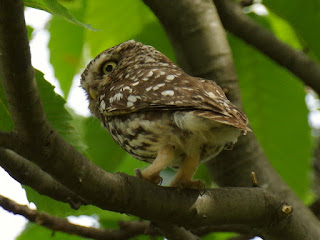There were several families of Blue Tits along the east side of the Long Water. Here are two pictures of parents feeding their young ones.
I hadn't seen the Bar-Headed Goose on the Serpentine for several days and had assumed that it had gone back to wherever it came from, probably Regent's Park, either on its own wings or because someone had arrived with a van and captured it. But today there was again a Bar-Headed Goose, near Bluebird Boats.
And there was another Bar-Headed Goose a bit along the shore, near the Lido restaurant. I thought it was the same one that had moved along while I wasn't looking, but it wasn't. Note the dark smudge on the side of its chest -- it has one on either side. Comparing pictures from a few days ago shows that this is the one I saw earlier.
The one in the upper picture has no smudges, but it has a dark shadow on its bill, and also the black stripe on its head extends the whole way to its eye. Both these features exist on both sides of its head. It would be interesting if these two birds were of opposite sex and became mates. There is a small population of feral Bar-Headed Geese in Britain already.
Apart from that it was a very ordinary day. The Black Swan was mooching around in the middle of the Serpentine, and didn't come over for his usual biscuit. Maybe moulting is making him feel itchy and irritable.
The White Mallard was with his normal-coloured mate, but he seems to be moulting too, as he is missing the little curly feathers above his tail that show that he is a drake. Unless, of course, this is a different white Mallard, but I don't think so.
Virginia Grey has brought a touch of distinction to today's post by sending me two splendid pictures. The female Mute Swan was carrying her cygnets when she climbed on to the little island in the Long Water, causing them to fall off.
And a Grey Heron had caught a very large perch and was turning it round in an attempt to swallow it head first. It flew away still holding its prey, so we don't know whether it succeeded in eating it. Herons are prone to grabbing things too large to swallow.
The young Coots on the Serpentine are quite large now, and have been capable of feeding themselves for some time, but that doesn't stop them from begging to be fed when their parents are around.
There were a lot of Swifts over the Serpentine.
No sign of the Little owlets, but this wasn't surprising as there was a Magpie in the chestnut tree looking at the nest hole.
When I came back later they were still out of sight, but their father was on a branch.












That is one good-looking goose.
ReplyDeleteLove the tumbling cygnets photo - clumsy mum! And that grey heron catch is special too.
Swifts still coming in off the sea down in Dorset today.
Well, two geese really. And thanks to Virginia for two splendid pictures.
DeleteThe cascade of cygnets is really eye-catching, but all photos are charming.
ReplyDeleteAll credit to Virginia for catching the moment.
DeleteAgree, the Bar-Headed Geese are handsome birds. Saw some free walking and flying at Kew Gardens a few years ago. Do you know to where they are native? I'm wondering if the markings are camouflage in certain environments (just speculating).
ReplyDeleteThey're native to northern India, spending the summer north of the Himalayas and the winter to the south, and migrating over the mountains at enormous altitudes. I'd describe the head pattern as simple disruptive colouring to mask the outline of the bird's head.
Delete